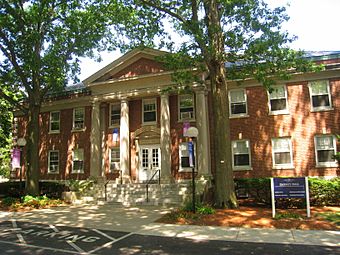Newton Theological Institution Historic District facts for kids
Quick facts for kids |
|
|
Newton Theological Institution Historic District
|
|

Dabney Hall, built in 1937
|
|
| Location | Roughly bounded by Braeland Ave., Ripley St. and Langley Rd., Bowen School Access Rd., and Cypress St., Newton, Massachusetts |
|---|---|
| Area | 44.7 acres (18.1 ha) |
| Architectural style | Colonial Revival, Queen Anne, Italianate |
| MPS | Newton MRA |
| NRHP reference No. | 86001749 |
| Added to NRHP | September 4, 1986 |
The Newton Theological Institution Historic District is a special area in Newton Centre, Massachusetts, recognized for its important history. It includes the campus of the Andover Newton Theological School, which was once called the Newton Theological Institution. This district also features a group of beautiful old houses from the 1800s located near the campus.
The school was the very first educational place in Newton that wasn't a public school. Because of its historical importance, the entire district was added to the National Register of Historic Places in 1986.
Contents
A Look at the School's History
The Andover Newton Theological School is the oldest school of its kind in the United States that welcomes students from different religious backgrounds. It was created in 1931 when two older schools joined together.
How the School Started
One of the original schools was the Newton Theological School. It began in 1825 and was the first Baptist seminary (a school for religious studies) in the country. The other school was the Andover Theological Seminary, founded in 1807.
The land in Newton Centre was bought by the Baptists in the 1820s. They built Farwell Hall in 1828. This is the oldest building on the campus that is still standing today. It was later updated in 1857 with a new roof style.
Growing the Campus
As more students came, new buildings were added. Colby Hall, built in 1866, is another important building. It's even listed separately on the National Register of Historic Places.
Other buildings followed, including Sturtevant Hall (1873), Burgess Gymnasium (around 1880), and Hills Library (1895). These buildings were all built before the two schools merged in 1931.
Historic Homes Nearby
Just north of the school campus, there's a small neighborhood with high-quality houses built in the mid-to-late 1800s. Some of these homes have connections to the school.
For example, the house at 70 Chase Street is a great example of the Second Empire architectural style in Newton. It was built for John Sanborn, who was a merchant and politician from Boston. The house at 120 Herrick Street, built in 1906, might have been used by the school to house visiting teachers. Another home at 102 Herrick Street, built around 1883, was once home to a clergyman (a religious leader).
Gallery






